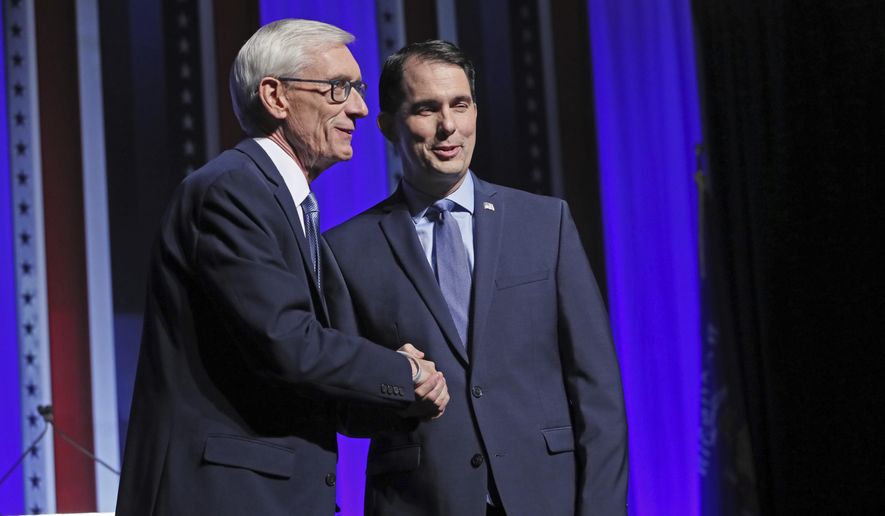The heartland, flyover country, the Rust Belt — whatever you call it, the swath of states along the Great Lakes from Pennsylvania to Wisconsin delivered the White House to President Trump in 2016.
That same region is poised for a major Democratic resurgence Tuesday.
After complaining that they were left behind by the Obama economy, the region is doing better — but that turns out to be a significant boost to Democratic incumbents who hold Senate seats in Pennsylvania, Ohio, Indiana, Michigan and Wisconsin, all of whom except Sen. Joe Donnelly in Indiana appear on track for easy wins.
Governorships are not much better for Republicans, with a Democratic incumbent in Pennsylvania holding a large lead in the polls, and Republicans are struggling to hold on to governor’s mansions in Michigan, Ohio and Wisconsin, none of which offers the party better odds than a jump ball.
Political pros say that doesn’t mean the 2016 political realignment was a fluke, but it does complicate the storyline that Mr. Trump had changed the region.
For G. Terry Madonna, director of the Center for Politics and Public Affairs at Franklin & Marshall College in Pennsylvania, it means finding ways to excite rural voters and hope overwhelming turnout there overcomes Democrats’ advantages in the cities.
“In order to win, you have to do what Trump did,” Mr. Madonna said. “You have to have the turnout, and the percentage that the Republican wins by has to be very large. You can’t win 51-49. You have to do what Trump did, winning 60-40.”
Wisconsin Gov. Scott Walker, fighting for his political survival, spotted the wave early on, after a liberal Democrat running an anti-Trump campaign won a statewide judicial election in April.
“Tonight’s results show we are at risk of a #BlueWave in WI. The far left is driven by anger & hatred — we must counter it with optimism & organization,” he said in a Twitter warning heard ’round the GOP.
Analysts have offered myriad reasons for the shift.
The Washington Post says it’s because Democrats nominated “generic” candidates in the Midwest compared with “fiery liberals” who are struggling in races elsewhere. FiveThirtyEight, an elections analysis website, crunched polling numbers and figures that white voters without college degrees in the Midwest are less excited about the Republican Party’s offerings this year than they were during the Trump-inspired 2016 campaign.
Jim McLaughlin, a longtime Republican Party pollster, said Mr. Trump’s 2016 victories were as much a rejection of the Obama years as they were an embrace of Trumpism. Voters felt left behind by the Obama economy and bought into Mr. Trump’s optimism that things could get better for them.
The pendulum has now shifted. Although the economy is doing better, the battleground this year is on different issues, he said.
“We haven’t yet proven to the electorate the Democrats are a threat to their prosperity and how they’re doing right now,” he said.
Still, Mr. Madonna said there is no doubt that the 2016 Trump victory was part of a realignment.
“In parts of southeastern Ohio, southwestern Pennsylvania, northeastern Pennsylvania, in those old mining and mill towns, they’re registered Democrats in those counties — Trump won them,” he said, adding that it wasn’t the first election when they moved away from the Democratic Party. “It started a decade or so ago, but it’s reaching maturity now.”
He said that doesn’t foreclose the Democrats’ chances by any stretch. In Pennsylvania, Sen. Robert P. Casey Jr. and Gov. Tom Wolf are expected to win by double-digit margins.
Michigan, meanwhile, is one of the places where Democrats are eyeing a pickup in the governor’s race and seem on track to hold serve in the Senate race.
Sen. Debbie Stabenow, seeking her fourth term, saw the polls tighten about two weeks ago, but the latest surveys show she has put distance between herself and Republican candidate John James.
Rob Yoon, contributing reporter and analyst at Inside Elections, said each race has its own dynamic. In the governor’s race, he said, Michigan has voted for a candidate opposite the party in the White House for the past six elections, and Democrat Gretchen Whitmer appears on track to capitalize this year.
The tightening polls in the Stabenow race, though, do show some of the Republican realignment.
“For an 18-year incumbent to even have that little bit of tightening, I think it shows that there is some undercurrent in the state that probably wasn’t there prior to the Trump victory,” said Mr. Yoon, who is also a visiting professor of journalism at the University of Michigan.
He said he will be watching a couple of U.S. House races, one with a retiring Republican incumbent and the other with a Republican battling for his political future, for more signs of a realignment.
“Especially in what’s been seen as a blue wave year, if Republicans are able to still pull those races out that would be a sign of continued or growing Republican strengths post-Trump,” he said.
Whether that sets up Mr. Trump for a better 2020, though, remains to be seen.
Mr. Madonna noted that the parties of the past three presidents had crushing losses in their first-term congressional elections. Presidents Reagan, Clinton and Obama each won second terms two years later.
What Mr. Madonna was certain of is the battleground: “We’ve got four states, the Rust Belt states, that are going to be very much in play.”
• Stephen Dinan can be reached at sdinan@washingtontimes.com.




Please read our comment policy before commenting.